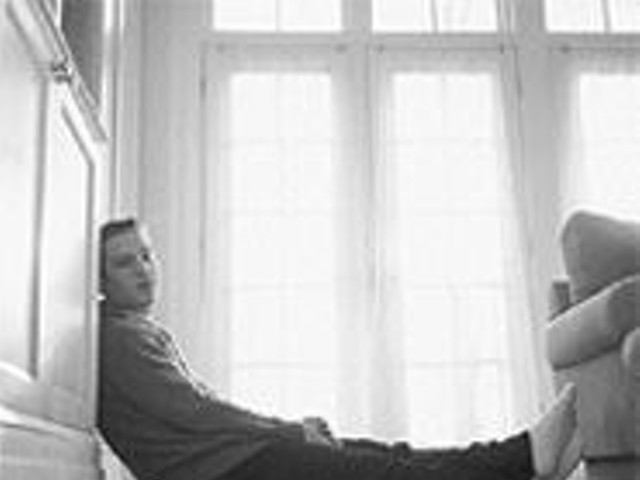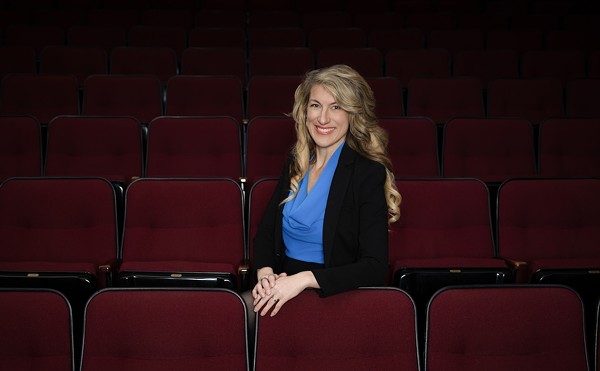The retrospective is now making its way to St. Louis, thanks to the efforts of Sabine Eckmann, curator of the Washington University Gallery of Art. Eckmann herself came to St. Louis from the Los Angeles County Museum of Art in 1999. She is organizing the retrospective's incarnation at Washington University, which will include almost all the works seen in LA, minus three large-scale filmic installations. The show opens Friday, Sept. 8.
The exhibition will give viewers a chance to assess Antin's entire oeuvre, which is remarkable. It contains some of the most groundbreaking early conceptual works of the 1960s and '70s, such as her "Blood of a Poet Box" (1965-68); "Carvings: A Traditional Sculpture" (1972), a quasi-scientific photodocumentation of the artist's nude body as she diets to achieve the "ideal" female shape; and early feminist video works like "Representational Painting" (1971).
Of course, the retrospective also includes Antin's best-known work, "100 Boots." Between 1971 and 1973, Antin photographed 50 pairs of boots as they journeyed across the country, beginning at the Pacific Ocean and ending with their arrival at the Museum of Modern Art in New York, where they were featured in a retrospective exhibition of their own. Along the way, the photos tell us that the boots had a pretty good time: They went shopping, climbed trees, rode the ferry, went to the movies and visited a farm.
Antin mailed postcards of the photographs to hundreds of recipients around the world, who waited eagerly for the next installment of the boots' adventures. After their 1973 exhibition in New York, it looked as if the boots would be permanently put to rest. But they've come back for an encore with this retrospective exhibition. In 1999, Antin photographed the boots in Los Angeles, and recently she photographed them in St. Louis, making a visit to the Gateway Arch and the mighty Mississippi.
"100 Boots" has become, for better or worse, the artist's "signature piece," the one she is most often identified with. It's easy to understand why: The boots are just so darn cute. But that cuteness can detract from an understanding of the work's importance. By mailing the postcards of "100 Boots," Antin -- like the conceptual artist Ray Johnson before her -- was investigating alternative modes of distributing and exhibiting art. And the work is also an investigation into forms of storytelling and fictional narratives, which provide the conceptual backbone of all of Antin's works.
Antin is a masterful storyteller, and creating characters is her forté. In "California Lives" (1969) and "Portraits of Eight New York Women" (1970), Antin represents individual characters -- not by their pictures but by the material trappings that describe them. A folding TV tray with a cigarette and hair curler give us a wonderful portrait-in-absentia of "Jeanie," as do the wood easel, jar of honey and crushed crimson velvet that portray Antin's friend and fellow New York artist Carolee Schneemann.
More recent films see the artist continuing to explore narrative forms and the lives of fictional characters. "The Man without a World" (1991), a silent film by the fictional director Yevgeny Antinov, tells the story of the doomed romance between a Yiddish poet and a "nice" girl in a Jewish shtetl in Eastern Europe. In "Music Lessons" (1997), an anorexic woman from a working-class family dreams of becoming a model and concert violinist.
Much of Antin's career has been devoted to developing a series of elaborate characters that she herself has performed and documented in various ways. The three major personae in Antin's repertoire are "The King," "The Nurse" and "The Ballerina." These characters have metamorphosed over the years, but they always bear some relationship to Antin. She uses them as opportunities to explore both general concepts of "selfhood" and aspects of herself.
"The Ballerina" originally represented Antin's idealized female self. As the Ballerina, Antin videotaped and photographed herself, striking idealized ballet poses, experiencing a private moment "backstage" and, in an early video, meeting a bum on a freight train, where she describes her dream of making it as a ballerina in the "Big City."
The early Ballerina persona was eventually transformed into Eleanora Antinova, a more fully developed character with a documented history. Antinova, according to the "evidence" we have of her life, is a legendary black prima ballerina who danced with the Ballets Russes. In performances, films, drawings, plays and memoirs, Antinova's fictional history and personality are documented. She emerges as an utterly convincing character, distinct from the artist but manifesting certain aspects of Antin's own experiences.
Antin's character exploration and role-playing certainly call to mind artists like Adrian Piper and latter-day masqueraders like Cindy Sherman and Yasumasa Morimura. But artists like Sherman and Morimura are more interested in mute characters that manifest certain cultural determinants. Antin's characters are much more sustained, much more fleshed-out. They possess extended lifespans and elaborate histories that invite us, and Antin herself, to check in on them periodically, to see what they are up to today.
Given that many of Antin's characters refer to aspects of her own personality, the prospect of a retrospective exhibition takes on new meaning. Asked how she feels about the retrospective, Antin responds, "It's weird. It's like looking at your life. I had to look at all these characters I created and decide whether I liked them or not. And I decided I did."





